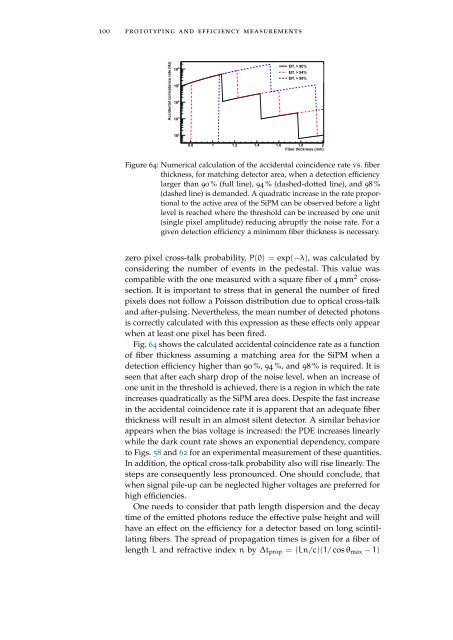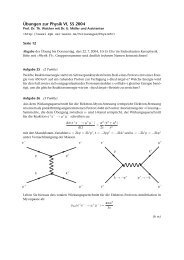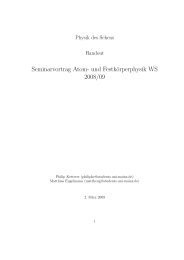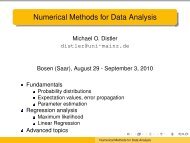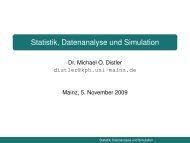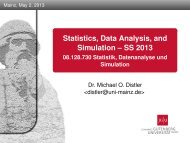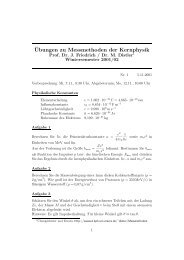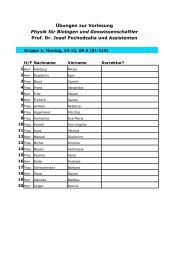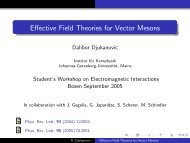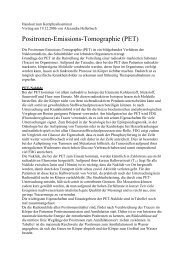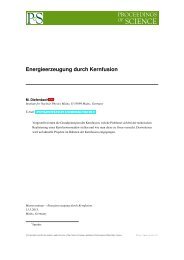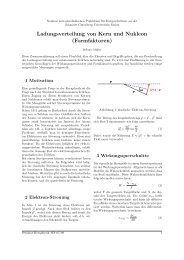A Classic Thesis Style - Johannes Gutenberg-Universität Mainz
A Classic Thesis Style - Johannes Gutenberg-Universität Mainz
A Classic Thesis Style - Johannes Gutenberg-Universität Mainz
Create successful ePaper yourself
Turn your PDF publications into a flip-book with our unique Google optimized e-Paper software.
100 prototyping and efficiency measurements<br />
Accidental coincidence rate (Hz)<br />
6<br />
10<br />
5<br />
10<br />
4 10<br />
3<br />
10<br />
2 10<br />
Eff. > 90%<br />
Eff. > 94%<br />
Eff. > 98%<br />
0.8 1 1.2 1.4 1.6 1.8 2<br />
Fiber thickness (mm)<br />
Figure 64: Numerical calculation of the accidental coincidence rate vs. fiber<br />
thickness, for matching detector area, when a detection efficiency<br />
larger than 90 % (full line), 94 % (dashed-dotted line), and 98 %<br />
(dashed line) is demanded. A quadratic increase in the rate proportional<br />
to the active area of the SiPM can be observed before a light<br />
level is reached where the threshold can be increased by one unit<br />
(single pixel amplitude) reducing abruptly the noise rate. For a<br />
given detection efficiency a minimum fiber thickness is necessary.<br />
zero pixel cross-talk probability, P(0) = exp(−λ), was calculated by<br />
considering the number of events in the pedestal. This value was<br />
compatible with the one measured with a square fiber of 4 mm 2 crosssection.<br />
It is important to stress that in general the number of fired<br />
pixels does not follow a Poisson distribution due to optical cross-talk<br />
and after-pulsing. Nevertheless, the mean number of detected photons<br />
is correctly calculated with this expression as these effects only appear<br />
when at least one pixel has been fired.<br />
Fig. 64 shows the calculated accidental coincidence rate as a function<br />
of fiber thickness assuming a matching area for the SiPM when a<br />
detection efficiency higher than 90 %, 94 %, and 98 % is required. It is<br />
seen that after each sharp drop of the noise level, when an increase of<br />
one unit in the threshold is achieved, there is a region in which the rate<br />
increases quadratically as the SiPM area does. Despite the fast increase<br />
in the accidental coincidence rate it is apparent that an adequate fiber<br />
thickness will result in an almost silent detector. A similar behavior<br />
appears when the bias voltage is increased: the PDE increases linearly<br />
while the dark count rate shows an exponential dependency, compare<br />
to Figs. 58 and 62 for an experimental measurement of these quantities.<br />
In addition, the optical cross-talk probability also will rise linearly. The<br />
steps are consequently less pronounced. One should conclude, that<br />
when signal pile-up can be neglected higher voltages are preferred for<br />
high efficiencies.<br />
One needs to consider that path length dispersion and the decay<br />
time of the emitted photons reduce the effective pulse height and will<br />
have an effect on the efficiency for a detector based on long scintillating<br />
fibers. The spread of propagation times is given for a fiber of<br />
length L and refractive index n by ∆tprop = (Ln/c)(1/ cos θmax − 1)


